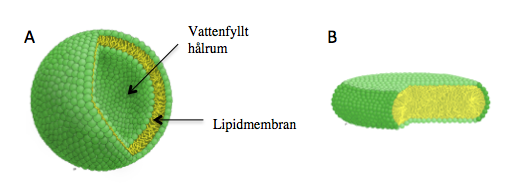Colloid and Interface Chemistry
Our research in surface and colloid chemistry
Liposomes are small hollow fat particles made up of a closed lipid membrane. In living cells, they function as containers for substances and substances to be imported or exported through the cell membrane and are also used for the transport of substances between the various parts of the cell. Formation and destruction of proteins and other vital molecules takes place in liposome-like structures, and the cell membrane that surrounds all living cells can be seen as a giant liposome. In our research, we use artificial liposomes to study processes that take place in or between lipid membranes. Biologically important questions include how it happens when a lipid membrane opens, what determines how stiff and dense the membrane is, and what happens when two individual membranes, in so-called fusion, merge into one. We also use liposomes, and other closely related lipid particles, as models when studying how different drugs, as well as proteins/peptides and other biomolecules, interact with and affect the properties and structure of biological membranes. For certain types of studies, a new type of lipid particles, so-called lipodiscs, which we developed within the research group, has proven to be a very beneficial alternative to liposomes.

Liposomes and lipodiscs have properties that make them interesting also from a medical and pharmaceutical point of view. By varying the lipid composition and the production method, the particles can be adapted to transport a wide range of different molecules and substances. Since the particles can be constructed from harmless, body-specific molecules, they are very suitable as drug carriers. With the help of recently developed methods, liposomes and lipodiscs can also be provided with targeting molecules. With the help of the target seekers, it is possible to direct the particles specifically to different tissues and cells, such as cancer cells. In collaboration with medically and pharmaceutical-oriented research groups, we run several projects with the aim of developing liposomes and lipodiscs for the formulation and transport of medicines. Our research in this area includes e.g. a project focusing on targeting lipodiscs for the formulation and transport of insoluble cancer drugs. In another project, the objective is to develop lipodiscs for the administration of antibacterial peptides. In this case, the long-term aim is to develop new treatment options that can contribute to solving the major problems with antibiotic-resistant bacteria.
Within the projects, e.g. a special type of electron microscopy, so-called cryo-transmission electron microscopy (cryo-TEM), which makes it possible to directly image e.g. liposomes and lipodiscs. In our studies, we combine cryo-TEM with other, more indirect, methods based on light scattering and fluorescence-based techniques.
Contact
- If you have questions about our research, you are welcome to contact Katarina Edwards.
- Katarina Edwards
